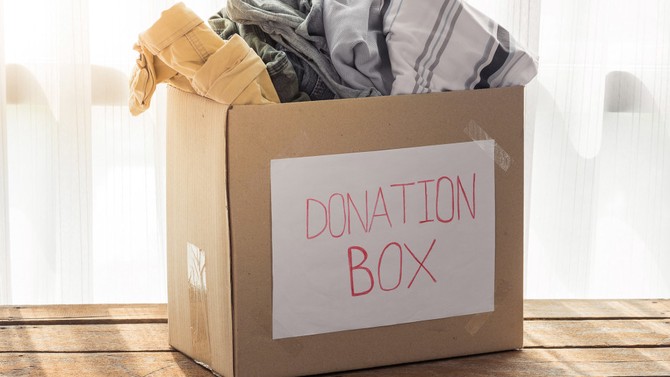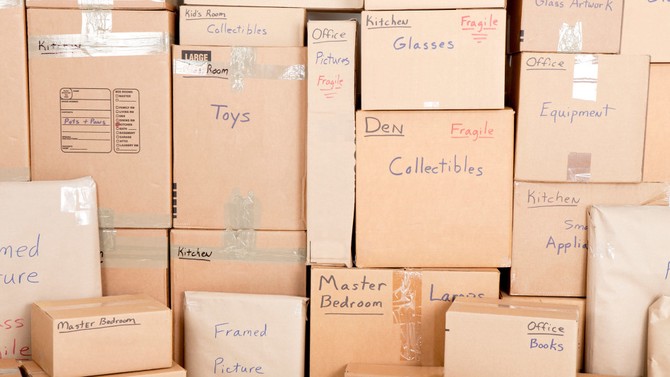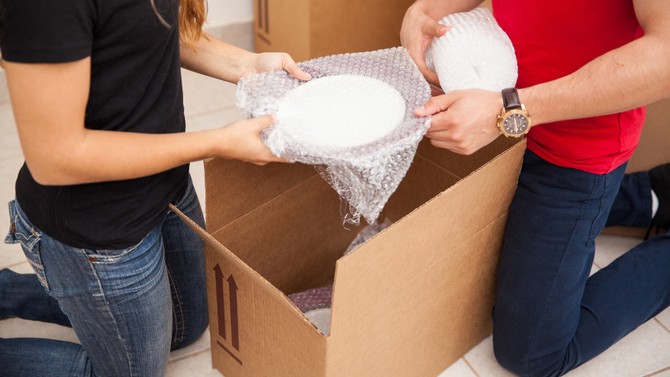6 Moving Mistakes Couples Make
Whether you're moving in together for the first time or are relocating for the nth time, you'll want Peter Walsh's strategies for packing, unpacking and not killing each other along the way.
By Pamela Masin

Photo: PeopleImages/istock
Mistake #1: They Forget to Have the Big Talk
Turns out 58 percent of Americans see moving in together as a bigger challenge for couples than planning a wedding, according to a new survey by SpareFoot, a storage marketplace company. What's more, 31 percent (and 46 percent of millennials) report that they've had their worst arguments while moving with their significant other.
Organizational expert Peter Walsh has key strategies to surviving the moving process. "Before you relocate, you should openly discuss what hobbies you have, what activities might take place in various rooms, or what you think is an important function for the space," he says. "Then you will have to negotiate and decide on the best purpose for the various rooms to suit your lives." For instance, if you love to read and your partner is a gamer, you need to decide how many shelves will hold books and how many will be reserved for consoles, so no one is resenting the other person's stuff.

Photo: Kerkez/istock
Mistake #2: They Skip Doing the Math
The single biggest misstep Walsh sees when couples move: not packing for the space they're moving to. "People pack up everything in their current home," he says, but their new place may have less room or smaller closets or no attic. To avoid having too-big furniture that doesn't quite fit the living room or boxes piled up in the garage, Walsh recommends doing a "space audit"—a detailed method of measuring that ensures everything you unpack in your new home has a spot to be placed or stored away.
To determine how much room you have in your new home for the things you own, start by measuring the rooms and creating a blueprint. Then, take down more specific details like the amount and size of the kitchen drawers, the height and width of the closets, the number of display shelves in the living room, the position of doors and windows, and so forth. "For example, if you currently have 10 feet of hanging space for clothes but in your new home you only have 5 feet of hanging space, then it is obvious that you need to reduce the volume of hanging clothes you have by 50 percent," says Walsh. "This sets clear limits for the number and volume of things that you can keep and that will fit, which, in turn will help limit the amount of clutter."

Photo: sirastock/istock
Mistake #3: They Underestimate Purging Time
It seems like 2 or 3 weeks should be plenty of time to pack, right? Not in Walsh's experience. "Think about packing 2 to 3 months before you move and spend a half hour each night pulling out stuff from a specific spot, like a single cupboard or closet, and purge items that you don't need or wear," says Walsh. (If you and your partner disagree on what to keep and what to toss, here's a simple way to figure out what to get rid of that'll quickly squash an argument.)
Walsh says that many of his clients cut down their belongings by 60 percent when they purge their home before a move. Bonus: That's a whole lot fewer rolls of packing tape to buy and fewer boxes to pay movers to carry.
And pro tip: Before you make more of a mess with piles on the floor of stuff to donate, set up a clearly labeled donation box that you can quickly toss items into while you're decluttering, Walsh suggests.

Photo: AleksandarNakic/istock
Mistake #4: They Only Pack According to Room
You might already know to pack your belongings into boxes by room, but for an even more stress-free and efficient move, Walsh recommends organizing the nitty-gritty within each box.
The Macro Idea: Remember his biggest moving mistake, which is of packing up the home you're in and not the one you’re moving to? That applies here as well. Instead of boxing items by the room they're coming out of, pack for the new room the items are going in to.
The Micro Idea: Next, pack stuff by categories like T-shirts, jeans and dishes. "This will not only help you while unpacking, but it also allows you to see how much of a particular item you have." So, when you discover 20 pairs of khakis in your "pants" box, make sure half (at least) of those don't make it with you to your new address.

Photo: Aneese/istock
Mistake #5: They Label Boxes the Wrong Way
Since movers don't know which room you consider "guest bedroom" or the "playroom," this traditional system can lead to unexpected chaos. Instead, try the method Walsh used on his own moving day: Assign each room a number and stick that number above each door. Then, label the boxes that should go in a room with its corresponding number. "You should even do this for the cupboards or the closets so the boxes are placed right in front [of their future home] and you have to move as little as possible," says Walsh. For example, a box could be marked "room 1, closet 1," with a numbered sign not only on the door to, say, that bedroom but also on its walk-in closet.

Photo: Antonio_Diaz/istock
Mistake #6: They Don't Fully Prep the Fragile Items
According to the SpareFoot survey, the number one thing people are most concerned about during a move is their belongings getting damaged. While it's somewhat out of your control if you hire movers, Walsh's packing techniques can help prevent a broken-heirloom induced meltdown.
1. Don't overload the boxes. Buying the largest-size box may save you on the number you (or the movers) need to lift, but it's actually putting your items in danger of breaking because the boxes end up becoming very heavy to lift. Instead, buy the medium-size boxes and pack them so you can pick them up. And, yes, this rule applies even if you're hiring much-stronger movers—to avoid any potential disasters after they leave.
2. Use liquor boxes. Go to your local bottle shop and see if they'll give you a few boxes or allow you to purchase them (they'll most-likely be cheaper than the moving boxes at your local hardware store). Since they're designed to carry a dozen bottles at a time, they're great quality to securely hold heavier items.
3. Don't use bubble wrap. Invest in butcher's paper instead. Not only does it take up less room in boxes, but you also need to use less of it to protect breakables.
4. Use blue painter's tape. Black marker can easily be overlooked in the hustle of moving day. Make fragile boxes stand out by putting a strip of tape on one side with an arrow to show which way is up, then another strip of tape on the same side and across the top to mark that it's fragile—just be sure to tell movers that double strips of tape is code for "handle with care."
Want more stories like this delivered to your inbox? Sign up for the Oprah.com Home & Decorating Newsletter!
Published 07/17/2017

